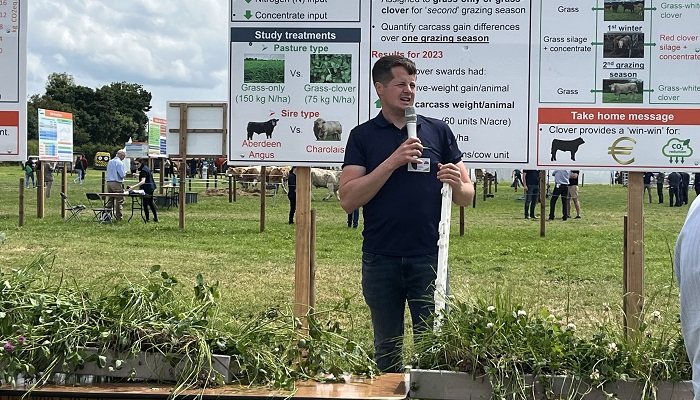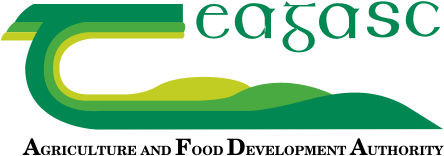01 July 2024
Lifetime clover systems study underway at Derrypatrick

Researchers in Teagasc Grange are examining the role clover – both white in grazing swards and red in conserved silage – can play in suckler beef systems through the Derrypatrick herd.
The current Derrypatrick research project herd centres on ‘developing more sustainable suckler beef systems in the context of grass-clover swards and animal genetics’, attendees at the recent BEEF2024 Open Day heard.
Explaining the objectives of this research, Dr Peter Doyle, Research Officer at Teagasc, explained that through using an 80-cow, spring-calving herd stocked at 2.2 livestock units/ha (170kg organic N/ha), it aims to increase farm profitability and decrease environmental footprint through reducing animal finishing age, concentrate input and nitrogen fertiliser input.
Commencing in 2023, the objective of the experimental work is to fill the knowledge gap in how clover inclusion in beef systems effects animal performance.
Dr Doyle said: “In Derrypatrick at the moment, we are comparing a grass-only versus a grass-clover system. The grass-only system is receiving 120 units/ac of nitrogen and half that (60 units/ac) is being applied on the grass-clover swards.”
The relationship between animal genetics and the potential links it may have to performance on such swards is also being examined through the use of Aberdeen Angus and Charolais sired calves.
Although the study is ongoing and much of the data being presented is from one year’s work, preliminary results to date are positive.
The first study, which commenced in spring 2023, monitored the performance of eighty 12-month old steers and heifers over one grazing season. These animals were assigned to either a grass-only or grass-clover treatment at the start of the grazing season and remained on their assigned pastures up until finishing in October.
Commenting on the key findings, Dr Doyle said: “At the end of the grazing season, the grass-clover animals had a 23kg higher liveweight gain per animal and that resulted in a 14kg heavier carcass weight just by having that white clover in the sward.
“We also reduced fertiliser input and with the higher carcass weight achieved, the combination resulted in a 16% higher net margin per hectare and lower greenhouse gas emissions from the grass-clover system.”
Although these results were achieved over an eight-month period, the research project is also examining how clover inclusion affects suckler animal performance from birth through to finish.
On this study, Dr Doyle said: “From birth, calves were assigned to either a grass-only system – where they are grazed with their dams on grass-only swards in the first year, offered grass silage and 1.5kg of concentrate over the first winter and grass-only in the second grazing season – or a grass-clover system, where they are grazed on grass-white clover swards in the first year, before being housed as weanlings and offered grass-red clover silage and 1.5kg of concentrate over the winter, and then turned out for the second grazing season on grass-white clover swards. The results of this part of the trial will become available toward the end of the year when the first batch of animals are finished.”
